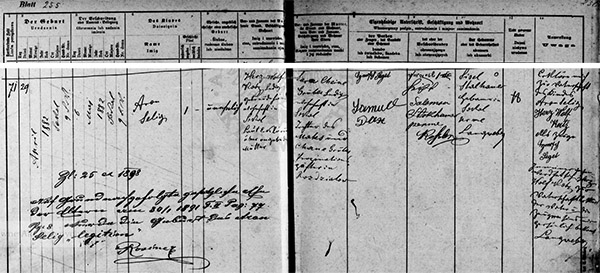Aron Selig Katz and family
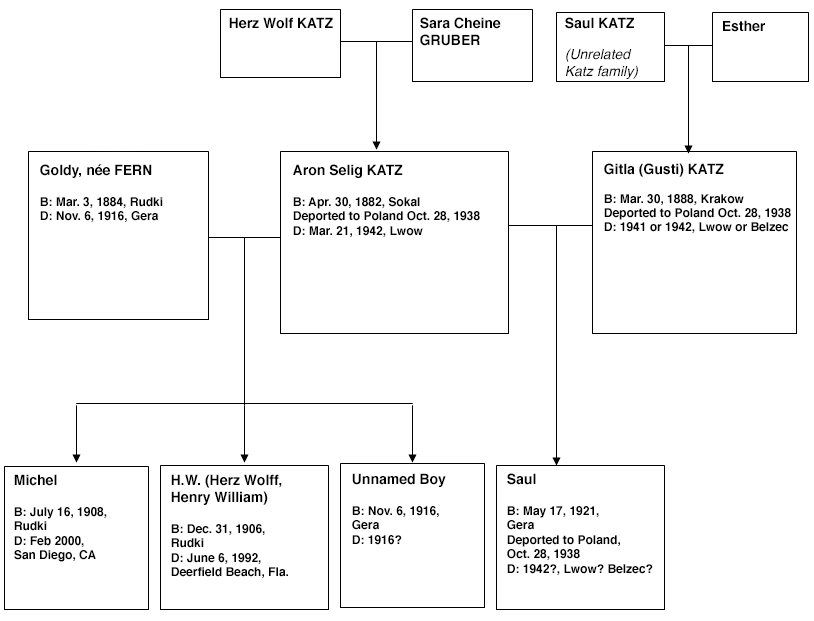
Aron Katz - family tree.
Aron Selig Katz was born April 30, 1882 in Sokal, the son of Herz Wolf Katz and Sara Cheine Gruber.
|
Sokal PSA AGAD, Lwow Wojewodztwa / Ukraine Records from: Births 1858-1905 |
|||||||
|---|---|---|---|---|---|---|---|
| Given Name | Year | Type | Akta | Sex | Father | Mother | Mother Town |
| Aron Selig | 1882 | Birth | 71 | M | Herz Wolf KATZ | Sara Cheine GRUBER | Rozdzalów |
Note that the house seems to be #9, which doesn't match the location of the other births in the family (#23 and #34).
Aron married Golda (Goldy) Fern from Rudki, a small shtetl about 80 miles (130kms) from Sokal. In 1880, Rudki had a population of approximately 2,500, about 50% of whom were Jewish.
It was common practice at the time for the groom to move to the home of the bride's parents, explaining why Aron moved from Sokal to Rudki. It is assumed that the couple lived in Goldy's parents' home, at least initially. Her parents were innkeepers and belonged to the shtetl's middle class.
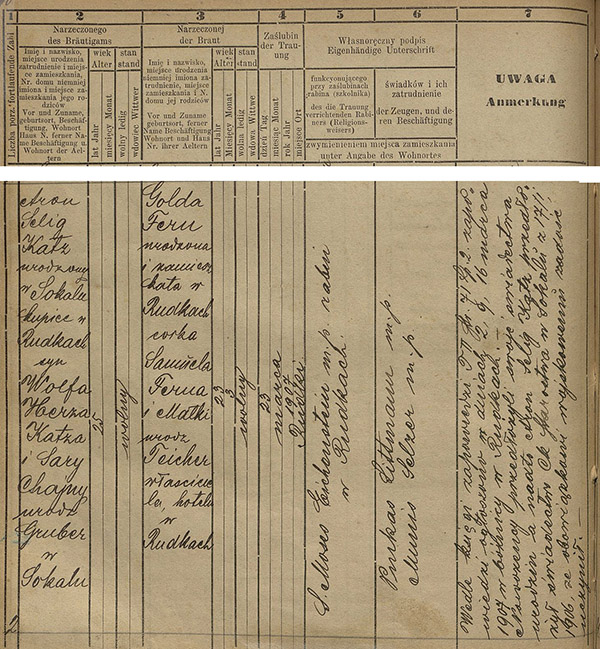
Aron and Golda's legal marriage (1907)
Source: AGAD (Central Archives of Historical Records in Warsaw)
(Via Yossi Mund)
Aron Selig Katz, born in Sokal, merchant in Rudki,
son of Wolf Katz et Sara Chajny, née Gruber
married Golda Fern, born and living in Rudki,
daughter of Samuel Fern and Malka, née Teicher, innkeeper in Rudki.
The civil marriage is dated March 23, 1907. At the time, Aron was 25 and Goldy 23. The actual marriage could have taken place up to six or seven years earlier. However, since religious records from Jewish communities have not survived, we can only guess when the marriage actually took place.
In Rudki, Aron owned a furniture store.
Aron and Golda's son Herz Wolff was born on December 31st, 1906, in Rudki. He was named after his grandfather, Herz Wolf Katz. (He would later change his name in the USA to Henry William Katz.)
A second son, Michel, was born a year and a half later in July 1908.
In 1910, another child, Hersch, was born. Aside from his birth record, nothing else is known about him. It is assumed that he died as an infant, sometimes before 1914.
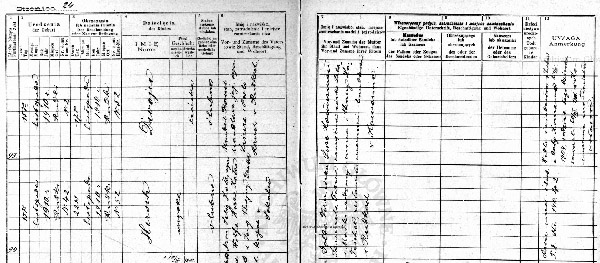
Hersh Katz birth record, 1910.
Source: AGAD (Central Archives of Historical Records in Warsaw)
(Via Yossi Mund)
The New World
Aron Katz left Rudki and arrived in Hamburg, probably in early 1913. There, he boarded the S.S. Amerika on February 25, 1913, bound for New York.According to the ship manifest, his final destination was Montreal, where he had an acquaintance named Josef Zunand (?) (Zuirand?). It is assumed that he hoped to settle in the New World and planned to later bring his wife and two sons. However, he either did not find the opportunities he was seeking or simply did not succeed, and he returned to Europe after a few months.

S.S. Amerika manifest, 1913.
Source: www.myheritage.com
List or Manifest of Alien Passengers for the United States Immigration Officer at Port of Arrival
Third Class
SS Amerika
Sailing from Cuxhaven* 5 Feb 1913 (* Cuxhaven was the registration point for Hamburg)
Arriving at port of New York - March 1913
Family Name: Katz
Given Name: Aron
Years: 31* (* = DOB ~ 1882)
Married
Occupation: Merchant
Read: Yes;
Write: Yes
Nationality: Austrian
Race or People: Hebrew
Last Permanent Residence:
Country: Austria
City or Town: Rudki* (* Handwriting unclear; What looks like "Ruthki" must be a misspelling)
The name and complete address of nearest relative or friend in country whence alien came:
Wife: Golde Katz, Rudki
Final Destination
State: Queb* (* Quebec)
City: Montreal
Non Immigrant Alien
Whether having a ticket to such final destination: Yes
By whom was passage paid? Self
Whether in possession of $50*, and if less, how much? Yes (* $50 = $1500 in 2024)
Whether ever before in the United States, and if so, when and where? No
Whether going to join a relative or friend: and if so, what relative or friend, and his name and complete address.
Acq(aintance): Josef Zuirant (? illegible)
Montreal xxx 91 xxx ave xxx
Place of Birth
Country: Austria
City or Town: Sokol (= Sokal)
I was told about Aron's aborted attempt for a new life in America by my mother and her friend, Siegmund Spiegel. Both had read H.W. Katz' fictionalized account in Die Fischmanns, where Yossel goes to the U.S. and then returns to his family in Europe, and both mentioned the novel when describing the event. According to Spiegel,
"(He came to the US) in the early twenties... for a short time, and (he) came back to Gera. He liked it better in Gera. He had another brother here, (i.e. Max Katz) ... but... he went back!..."
Over time, the combination of fiction and hearsay resulted in several inaccuracies: instead of 1913, the date became the 1920's; the destination was now the USA instead of Canada, and his return had been to Gera instead of Rudki. (For this last discrepancy, Spiegel may have been partially correct when he stated that Aron "liked it better in Gera" than in America. As for the presence of his sibling there, this too was partially incorrect - his brother Max would immigrate to the USA six months after Aron, in September 1913.)
Germany
In 1914, sometime after his return from America, but presumably before the war, Aron came to Gera where his brother Mathes lived.
Following the outbreak of World War 1, Goldy and her two sons fled the advancing Russian army and came to Gera.
Her son Bill would later write:
"Escaping from the front line with a frightened, exhausted mother [...]. I cannot forget that I was a dirty, hungry refugee child on the country road."
At first, Aron Katz supported his family as a traveling salesman, peddling a variety of goods, including ironmongery and, later, furs. (Pedersen)
The earliest documented residence of the family was at Arndtstraße 3.
In Germany, Goldy adopted the name Jenny, which is how she would appear in the death record of their third child and in the cemetery register. Her headstone included both "Golda" in the Hebrew inscription and "Eugenia" in the German.
Death of Goldy
On November 6, 1916: Goldy gave birth to a third son, Josef. She died of childbirth fever soon after, on November 12. She was thirty-two years old. Her son Josef died shortly afterwards at the age of five months.
Goldy was buried in Leipzig. Since Gera did not have a Jewish cemetery, Orthodox Jews from Gera were often buried in Leipzig or in other nearby towns rather than in the municipal cemetery.

Jenny ("Eugenia") Katz's tombstone, Leipzig
Source: www.alter-israelitischer-friedhof-leipzig.com, via Matthias Weibrecht.
A woman devoted (?) to her husband and sons
Innocent (?), honest, and gentle in her actions
Golda, daughter of Shmuel Halevi (i.e. "the Levite")
Died on the 17th day of Cheshvan, 1916 (5677)
May her soul be bound up in the bond of life
Here lies my beloved wife, our dear mother
Eugenia Katz
née Fern
Died November 12, 1916 in Gera at the age of 32
The cemetery register contains the following information:
Jenny Katz
Date of Birth: March 3, 1884
Place of Birth: Rudki, Austria-Poland
Date of Death: November 12, 1916
Marriage to Gustel Katz
Sometime between 1917 and 1920, Aron Katz wed in a second marriage Gitla (Gusti), née Katz. At a time when mortality rates were high, it was common for parents to remarry soon after the death of a spouse in order to raise and support their children. The alternative for those who did not remarry was to send their children to an orphanage.
Gusti Katz was born in Krakow, the daughter of Saul Nuchem Katz and Ester Lea Rosenberg Katz. (Her birth name was Gitla, also spelled Gitel, Gitl. Gusti, or Gustl, was her secular name, short for Augusta.) She came from a very religious family which included several rabbis, although a sister of her mother converted to Catholicism.1
Aron and Gustel had one son, Saul, born on May 17, 1921.
Eve:
"Aron was 'talked into marriage' with a woman from Munich named Gustl, née Katz. She was extremely orthodox and [Bill] was not happy in that home. He moved out to a furnished room."
"[Bill] moved out of his home as a teenager, something almost unheard of. He spent much time in Mary's home and often ate in Leo and Frida's home. Saul was much younger and I do not think they ever came to know one another well."
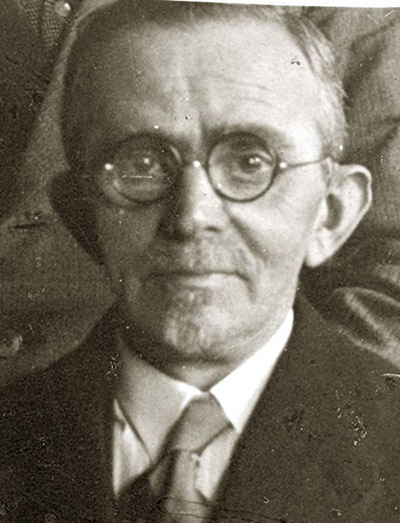
Aron Katz
Source: Yad Vashem (Submitted by his son Michael Katz)
Siegmund Spiegel:
“Gustel was a hard woman. A very ambitious woman. Constantly running. Her husband (Aron) walked around with a cane, very slowly…”
The family lived at Hospitalstraße 12, in Gera. (Now Karl-Liebknecht-Straße; Gera's Orthodox synagogue was nearby at Hospitalstraße 4.)
At the end of 1924, Aron and his brothers opened a shop together, with Leo acting as the manager. The joint venture was registered under the name "Katz Brothers" ("Gebruder Katz OHG") on December 8, 1924. The store sold linen and clothing articles ("Wäscheversand und Handel, Bekleidungsartikel") and was located at 6c Margarengasse, on the ground floor of the building where Leo's family lived.
The partnership lasted officially until December 31, 1933, at which point Leo continued to run the business on his own. Aron and Mathes then registered a separate business on January 20, 1934.
Poland
Aron, Gustl and Saul were deported to Poland on October 28, 1938 during the "Polenaktion", along with 17 000 Polish Jews. They were able to leave Bentschen (Zbaszyn) and came to Lwow (Lemberg). There they stayed at first with Aron's sister Zlate and her husband Chaim Teenenbaum.
Less than a year later in September 1939, Lwow was invaded by the Soviet Union. The city would remain under Russian control until 1941. Then, on June 30, 1941, the Germans invaded Lwów, and violence against the Jewish population began immediately. In early November 1941, the Germans established a ghetto.
Death of Aron
After the war, his son H.W. Katz learned that Aron Selig had been shot in Lwow "in the summer of 1941" because he had refused to enter a lorry taking Jews to a concentration camp.
It is likely that his death actually occured in the spring of 1942. An entry in a burial registry from Lwow records the death of an Aron Selig Katz on March 21, 1942, at the age of 60. While Aron Selig was still one month and nine days short of his sixtieth birthday, the odds of more than one 60-year-old Aron Selig Katz dying within the city of Lwow around that time - as opposed to being deported - are so low as to make it hard to conceived that it could have been a different person.
(According to a list derived from a census taken in Krakow in 1940, there were about 22,000 Jews in that city. Out of this total, only 140 were named Katz. Since the Jewish population in Lwow in 1941 was estimated to be between 130,000 and 150,000 - 7 times more than in Krakow - we can assume there were about 1,000 (140 * 7) Jews named Katz in Lwow at the time. Half, approximately 500, would have been men. Provided the age distribution was roughly equal between the ages of 1 and 60, there could have been at most ten 60-year old men named Katz in Lwow. The odds of more than one Katz being called Aron Selig - an uncommon name - are extremely low. Finally, since most Jews from Lwow were killed in deportation and not in the city, it is extremely unlikely that this was a different person.)
According to en.wikipedia.org, the Germans deported approximately 15,000 Jews from the Lwow Ghetto to Belzec between March 16th and April 1st, 1942. This aligns with the circumstances of Aron Selig Katz's death.

Burial entry for Aron Selig Katz
Source: collections.yadvashem.org
Aron Selig Katz was buried two days later, on March 23.
Assuming that this was indeed the Aron Selig Katz, the burial entry shows that he lived on 7 Pod Debem street, a small street in the north of Lwow, presumably in the Jewish quarter.
Death of Gusti and Saul
Following the deportations of 15,000 Jews in March-April 1942, another Aktion was carried out in August 1942, during which 40,000 to 50,000 Jews were rounded up and deported to Belzec. In January 1943, another 15,000-20,000 Jews were shot outside of the town. The Germans liquidated the ghetto in June 1943.
According to my mother's testimony, Gustel and Saul were deported to a death camp [Belzec]. According to Michael Katz's Yad Vashem page of testimony, Gustl and Saul were killed in the 1942 Lwow massacre. While it will most likely never be possible to know the exact circumstances of their deaths, it is assumed that they were murdered some time in 1942 or in the middle of 1943 at the very latest when the Lwow ghetto was liquidated.
- Special Thanks:
- Yossi Mund (links to genealogical records, 2021).
- Bogdan Dabrowski (additional information on Gusti Katz's family, 2023).
- Matthias Weibrecht (Stolpersteine for the Katz family, and link to Goldy ("Jenny") Katz's tombstone, 2025)
- Sources and References
- Yad Vashem (Aron)
- collections.yadvashem.org (Burial entry)
- 1: Bogdan Dabrowski, a descendant of Gusti Katz's family. (2023)
- en.wikipedia.org (Lwow Ghetto)
- www.bundesarchiv.de (Gedenkbuch)
- www.bundesarchiv.de
- Ena Pedersen : Writer on the Run: German-Jewish Identity and the Experience of Exile in the Life and Work of Henry William Katz (2001)
